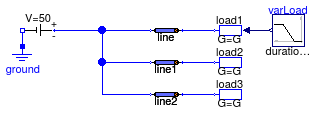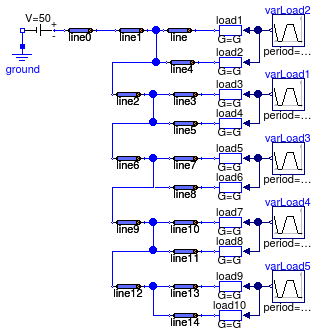

Package with example models
This package contains examples for the use of models that can be found in Buildings.Electrical.DC.Lines.
Extends from Modelica.Icons.ExamplesPackage (Icon for packages containing runnable examples).
| Name | Description |
|---|---|
| Example model to test the DC lines | |
| Example model to test the possible combinations between line and load models | |
| Example model to test the possible combinations between line and load models | |
| Example model to test for the DC RC two port model | |
| Example model to test for the DC resistance two port model |
 Buildings.Electrical.DC.Lines.Examples.DCLine
Buildings.Electrical.DC.Lines.Examples.DCLine
Example model to test the DC lines

This model is a simple test case that show how to use a line model and parametrize it using a commercial cable.
Extends from Modelica.Icons.Example (Icon for runnable examples).
 Buildings.Electrical.DC.Lines.Examples.DCLines
Buildings.Electrical.DC.Lines.Examples.DCLines
Example model to test the possible combinations between line and load models

This model shows a DC grid with 10 loads and 16 cables.
Each cable is of length l = 10 meters, a parameter that can be modified.
Each load can be either be a full nonlinear model, or be replaced by the
linearized version. The parameter linearLoads = false
can be used to switch between linear and nonlinear implementation.
This model can be used to test how the linearized loads are affected by the voltage drop caused by the lines. The longer the distance between the load and the source, the bigger is the voltage drop and thus the error introduced by the linearization.
Extends from Modelica.Icons.Example (Icon for runnable examples).
| Type | Name | Default | Description |
|---|---|---|---|
| Boolean | linearLoads | false | Flag that selects between linearized or nonlinear load models |
| Real | L | 10 | Lenght of each cable |
 Buildings.Electrical.DC.Lines.Examples.DCLinesLinearized
Buildings.Electrical.DC.Lines.Examples.DCLinesLinearized
Example model to test the possible combinations between line and load models

This model is the linearized version of the model Buildings.Electrical.DC.Lines.Examples.DCLines and can be used to test how the linearized loads are affected by the voltage drop caused by the lines. The longer the distance between the load and the source, the bigger is the voltage drop and thus the error introduced by the linearization.
Extends from Buildings.Electrical.DC.Lines.Examples.DCLines (Example model to test the possible combinations between line and load models).
| Type | Name | Default | Description |
|---|---|---|---|
| Boolean | linearLoads | true | Flag that selects between linearized or nonlinear load models |
| Real | L | 10 | Lenght of each cable |
 Buildings.Electrical.DC.Lines.Examples.RCModel
Buildings.Electrical.DC.Lines.Examples.RCModel
Example model to test for the DC RC two port model

This model shows how to use a two port resistance-capacitance model.
The example also shows a comparison between the dynamic and steady state version model
that can be selected by changing the boolean flag use_C.
In this example the RC connects an ideal constant voltage source with a short circuit. The steady state current value passing through the RC model depends just on the value of R.
The RC model implement a T-model to represent the electric connection between the two connectors (see Buildings.Electrical.DC.Lines.TwoPortRCLine for more details).
The capacitance C see an equivalent Thevenin's resistance that is equal to REQ = 0.5 R and thus the time constant associated to the capacitance is
τ = REQ C = 0.5 R C = 2 seconds,
thus the duration of transient period is about 10 seconds.
Extends from Modelica.Icons.Example (Icon for runnable examples).
 Buildings.Electrical.DC.Lines.Examples.Resistance
Buildings.Electrical.DC.Lines.Examples.Resistance
Example model to test for the DC resistance two port model

This model shows how to use a two port resistance. In this example the resistance connects an ideal constant voltage source with a short circuit. The current flowing through the circuit depends just on the value of the two port resistance.
Extends from Modelica.Icons.Example (Icon for runnable examples).